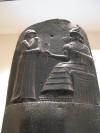|
"The code is inscribed on a tall black-basalt stele that was
carried off as booty to Susa [Persian capital] in 1157 B.C.
... At the top is a relief depicting Hammurabi in the
presence of the flame-shouldered sun-god Shamash. The
king raises his hand in respect. The god bestows on
Hammurabi the authority to rule and to enforce the laws...
The sculptor depicted Shamash in the familiar convention of
combined front and side views, but with two important
exceptions. His great headdress with its four pairs of
horns is in true profile, so that only four, not all eight,
of the horns are visible. And the artist seems to have
tentatively explored the notion of foreshortening -= a
device for suggesting depth by representing a figure or
object at an angle, rather than frontally or in profile.
The god's beard is a series of diagonal rather than
horizontal lines, suggesting its recession from the picture
plane."
- Gardner's
Art Through The Ages,
11th edition, Vol. I, pp. 29 - 30

"In the early eighteenth century B.C., King Hammurabi of
Babylon formulated a comprehensive law code for his people.
... Hammurabi was following the tradition his Sumerian
predecessors established. Two similar earlier law
codes survive in part, but Hammurabi's laws are the only
ones known in great detail, thanks to the chance survival of
a tall and narrow stele depicting Hammurabi receiving the
measuring rod and line from the god Shamash. The rod
and line symbolize the authority to measure people's lives,
that is, to render judgments. The sculptor thus
informed viewers that Hammurabi had the god-given authority
to enforce the laws spelled out on the stele. The
judicial code, written in Akkadian, was inscribed in
thirty-five hundred lines of cuneiform characters.
Hammurabi's laws goverened all aspects of Babylonian life,
from commerce and property to murder and theft to marital
infidelity, inheritance, and the treatment of slaves."
- Gardner's
Art Through The Ages,
11th edition, Vol. I, p. 30

"[What follows is...] only a small sample of the infractions
described and the penalties imposed (which vary with the
person's standing in society).
If a man puts out the eye of
another man, his eye shall be put out.
If he kills a man's slave, he
shall pay one third of a mina.
If someone steals property from
a temple, he will be put to death, as will the person who
receives the stolen goods.
If a man rents his boat, and
the boat is wrecked, the renter shall replace the boat with
another. If a married
woman dies before bearing any sons, her dowry shall be
repaid to her father, but if she gave birth to sons, the
dowry shall belong to them.
If a man's wife is caught in bed with another man, both will
be tied up and thrown in the water."
- Gardner's
Art Through The Ages,
11th edition, Vol. I, p. 30
|